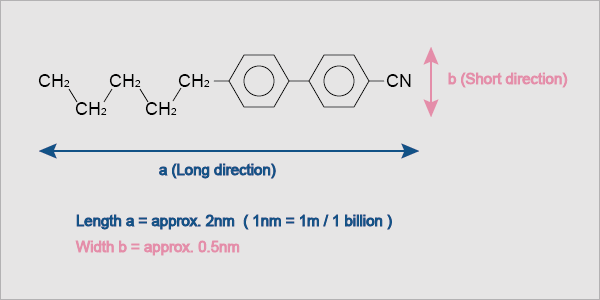Liquid Crystal Display Basics Knowledge
Blaze Display Technology Co., Ltd. | Updated: Nov 27, 2018

Liquid crystal
Liquid crystal refers to the intermediate status of a substance between solid (crystal) and liquid. When crystals with a high level of order in molecular sequence are melted, they generally turn liquid, which has fluidity but no such order at all. However, thin bar-shaped organic molecules, when they are melted, keep their order in a molecular direction although they lose it in molecular positions. In the state in which molecules are in a uniform direction, they also have refractive indices, dielectric constants and other physical characteristics similar to those of crystals, depending on their direction, even though they are liquid. This is why they are called liquid crystal. The diagram below shows the structure of 5CB (4-pentyl-4’-Cyanobiphenyl) as an example of liquid crystal molecules.
Principle of liquid crystal display
A liquid crystal display (LCD) has liquid crystal material sandwiched between two sheets of glass. Without any voltage applied between transparent electrodes, liquid crystal molecules are aligned in parallel with the glass surface. When voltage is applied, they change their direction and they turn vertical to the glass surface. They vary in optical characteristics, depending on their orientation. Therefore, the quantity of light transmission can be controlled by combining the motion of liquid crystal molecules and the direction of polarization of two polarizing plates attached to the both outer sides of the glass sheets. LCDs utilize these characteristics to display images.
LCD Construction
Simple facts that should be considered while making an LCD:
1.The basic structure of the LCD should be controlled by changing the applied current.
2.We must use polarized light.
3.The liquid crystal should able be to control both of the operations to transmit or can also able to change the polarized light.
We need to take two polarized glass pieces filter in the making of the liquid crystal. The glass which does not have a polarized film on the surface of it must be rubbed with a special polymer that will create microscopic grooves on the surface of the polarized glass filter. The grooves must be in the same direction as the polarized film.
Now we have to add a coating of pneumatic liquid phase crystal on one of the polarizing filters of the polarized glass. The microscopic channel causes the first layer molecule to align with filter orientation. When the right angle appears at the first layer piece, we should add a second piece of glass with the polarized film. The first filter will be naturally polarized as the light strikes it at the starting stage.
Thus the light travels through each layer and guided to the next with the help of a molecule. The molecule tends to change its plane of vibration of the light to match its angle. When the light reaches the far end of the liquid crystal substance, it vibrates at the same angle as that of the final layer of the molecule vibrates. The light is allowed to enter into the device only if the second layer of the polarized glass matches with the final layer of the molecule.

